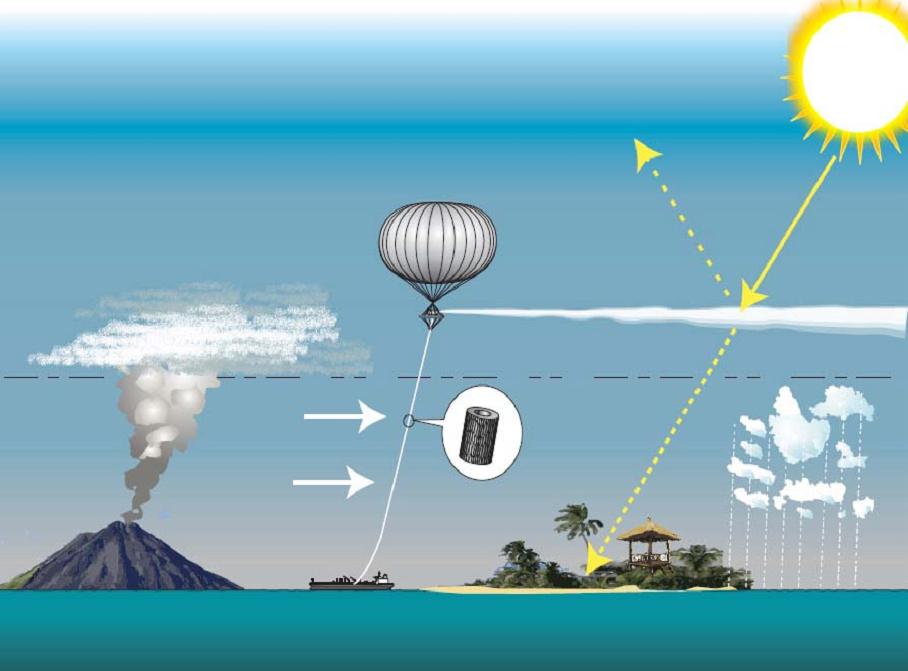This story is part of Covering Climate Now, a global collaboration of more than 250 news outlets to strengthen coverage of the climate story.
In 2019, I think it’s safe to say that humans are capable of wreaking great and terrible changes upon Earth’s systems. To name a few: acid rain, deforestation, and climate change. Reversing such problems is, on its face, quite simple. Stop releasing smog-forming pollution. Stop cutting down forests. Stop burning fossil fuels.
In some cases, humanity has risen to these challenges, and for example, greatly reduced acid rain in North America since the 1970s, 80s, and 90s. But when it comes to climate change, there’s a growing chorus, often bolstered by the fossil fuel industry, who support a controversial set of approaches to mitigating global warming, not by directly addressing the primary source of the problem — continuing to combust great volumes of oil, gas, and coal — but by further inducing massive changes to planetary systems.
I’m talking about geoengineering, and specifically solar geoengineering, which seeks to lessen global warming’s greenhouse effect by reflecting sunlight, and heat, back out to space.
Recently, an article in Forbes declared “we have failed on the preventive medicine side of global warming” and advocated for huge investments in solar geoengineering as perhaps “our only hope to reverse global warming.”
Shortly before the Forbes story, CNBC reported on a Bill Gates-funded project to develop the solar geoengineering technique known as a “solar cloud.”
How Bill Gates-funded solar geoengineering could help stop global warming by creating a giant chemical cloud around the whole planet https://t.co/hxm0g6XphP
— CNBC (@CNBC) September 7, 2019
Gates is funding work on Harvard University’s Stratospheric Controlled Perturbation Experiment. Harvard researchers are planning to release a small cloud of calcium carbonate over New Mexico (although the exact date and location have yet to be determined) as the first test of how the particles would interact in real atmospheric conditions.
Proposed solar radiation management using a tethered balloon to inject sulfate aerosols into the stratosphere. Credit: Hughhunt, CC BY–SA 3.0
In an October 2018 blog post, Bill Gates lays out his take on the challenges of stopping climate change and how his investments along with others are helping to advance research to address the issue. Though he nods to renewable energy, Gates largely glosses over the need to stop burning fossil fuels and instead discusses how many other sectors, besides electricity, contribute to climate change.
“Everyone who cares about climate change should hope we continue to de-carbonize the way we generate electricity,” he writes. Hope? I imagine a billionaire could help fund a lot of that kind of hope.
Meanwhile, the geoengineering work Gates helps fund is rapidly moving forward and is viewed by many as the only option we have to stop global warming — that is, if we continue burning fossil fuels.
In Washington, D.C., support for geoengineering is also on the rise. At a November 2017 Congressional hearing, Wired reported that Republican Rep. Randy Weber of Texas, chairman of the Energy Subcommittee of the House Committee on Science, Space and Technology, said, “The future is bright for geoengineering.”
Geoengineering’s Appeal: ‘Cheap’ and ‘Fast’ …
Without a doubt, decarbonizing the U.S. economy will be expensive, with estimates for plans like that of Senator and presidential hopeful Bernie Sanders reaching $16 trillion. While Sanders and others are stressing the need to invest in decarbonization, his plan also labels geoengineering as a “false solution” to climate change.
At the same time, alarming estimates about the cost of failing to decarbonize are pouring in. As The Nation recently reported, economists widely agree that the costs of climate change would easily exceed even the costs of the most ambitious plans to deal with the problem. But those investments to stop the problem would require investing the money in those solutions now, instead of waiting as climate change worsens and becomes even more expensive to address.
A new working paper on climate change from the National Bureau on Economic Research estimates that the impacts of a changing climate could significantly reduce gross domestic product (GDP) by 2100, the Washington Post reported last month.
Again, decarbonizing the economy will be expensive. Not dealing with climate change will likely be even more expensive. Which leads to one of the appeals of solar geoengineering: It is, relatively, very cheap.
As noted in Forbes, “Long-established estimates show that solar geoengineering is at least 100 times cheaper than cutting emissions” to offset temperature rise through 2100.
That column also credits Harvard’s Dr. David Keith, a leader in the field of solar geoengineering, as describing the technology as “cheap, fast, and imperfect.”
Meanwhile, the cost of renewable energy portfolios keeps dropping and threatening the prospects for natural gas power plants and pipelines. Renewables are very likely to be the cheapest way to generate power in the future and already have that title in many places in the world.
… and ‘Imperfect’
The recent CNBC article about Bill Gates noted some of those imperfections that might result from solar geoengineering. For starters, it could “cause massive changes in regional weather patterns and eradicate blue sky.”
These sorts of risks are a major driver of widespread opposition to solar geoengineering. As previously detailed on DeSmog, there are plenty of risks and concerns surrounding solar geoengineering (also known as solar radiation management), including the following:
Weather System Changes: According to a 2018 Climate Analytics briefing: “Solar radiation management would alter the global hydrological cycle,” which means changes to global weather patterns, including monsoon activity. Tweaking monsoon activity may not bode well for many people around the world. “These [monsoon] rains not only play a vital role in food security and exports, but also provide essential water for the very large, and often already vulnerable, populations,” states the briefing.
Ocean Acidification: Another negative impact of increased atmospheric carbon dioxide is the acidification of the oceans. Reflecting away sunlight does nothing to address this problem fundamentally caused by excess carbon dioxide.
Global Agriculture: While increasing atmospheric carbon dioxide concentrations can be beneficial up to a point for some plants, that benefit likely would be canceled out by the reduction in actual sunlight reaching plant life, which is necessary for photosynthesis.
Decreased Renewable Energy Production: As with agriculture, lower levels of sunlight reaching the Earth’s surface would reduce solar power production. And changing the global climate and weather could also alter wind power potential.
#Geoengineering is a danger to Earth+climate. Those pushing it are delaying real solutions. Same people who push it push nuclear, direct air capture, other useless techshttps://t.co/VcZOOomGos
Bill Gates-funded chemical cloud could help stop warming https://t.co/YzaOITlS4j
— Mark Z. Jacobson (@mzjacobson) September 8, 2019
If solar geoengineering cost as much to implement as decarbonizing the global economy, I doubt anyone would be seriously discussing it as an option, considering its incredibly high risks and limitations.
Fossil Fuel Industry Supports Geoengineering
In January, Topic magazine reported that as early as 1997, scientists at Exxon were well aware of the impacts of fossil fuels on the climate and were looking at ways to “save the planet,” which included forms of solar geoengineering such as placing giant mirrors in space to reflect sunlight.
Topic also notes that in 2015 then-ExxonMobil CEO Rex Tillerson explained how Exxon viewed dealing with climate change as simply an engineering problem. According to the magazine, Tillerson said, “Our plan B has always been grounded in our beliefs around the continued evolution of technology and engineered solutions to address and react to whatever the climate system and its outcomes present to us.”
Earlier this month, current ExxonMobil CEO Darren Woods told the audience at an energy conference that the company will continue to explore new investments in oil and gas for decades to come because “energy transitions take a long time.” When an entire industry’s profits and future prospects rely on delaying a global shift away from its products, then investing in a potential quick fix like geoengineering, despite its dangers and unknowns, makes a lot more sense.
The Exxon-funded American Enterprise Institute (AEI), a conservative think tank which has spread misinformation about climate change, held a day-long conference in 2008 titled “Geoengineering: A Revolutionary Approach to Climate Change.” It is far from the only conservative think tank with fossil fuel funding to embrace the “solution” of geoengineering while simultaneously bashing the science of climate change. Former GOP House Speaker Newt Gingrich, former Texas Rep. Lamar Smith, and other conservative politicians and activists have taken this approach as well.
As academic and author Jay Michaelson wrote in a 2013 compendium on geoengineering, this idea espoused by groups like AEI that “possible” climate change can be fixed through geoengineering appeals to conservatives both practically and ideologically. “On a simple level, [geoengineering] allows polluters to continue polluting … But it also is consonant with a wider and deeper conservative view that, essentially, the market and human innovation will eventually solve whatever problems they have created, with no need for complex and freedom-abridging government intervention.”
In February, DeSmog covered the new report “Fuel to the Fire: How Geoengineering Threatens to Entrench Fossil Fuels and Accelerate the Climate Crisis,” produced by the Center for International Environmental Law (CIEL), which made the case that the fossil fuel industry prefers geoengineering as an approach for addressing climate change because it allows the industry to keep arguing for continued fossil fuel use.
“For six decades oil companies have argued that climate change does not exist, that it’s not caused by human activity, and that if it is, it’s not a problem,” said Steven Feit, co-author of the CIEL report. “Now, these companies are claiming to accept that climate change is an engineering problem …Like their decades of denial, this action is profoundly dangerous.”
We know fossil fuel companies like Exxon knew about climate change decades ago and, instead of engineering a solution to the problem, actively attacked the science behind it. Perhaps the same people and companies who caused the problem and knowingly misled the public about it aren’t the right ones to trust on the best way to solve a problem they long denied was even one in the first place.
A False Solution
The appeal of solar geoengineering is understandable. Climate catastrophes are already here, and they have led to considerable anxiety and even nihilism about what to do. Just the latest high-profile example is novelist Jonathan Franzen’s recent suggestion (to much angry protest and correction) that we should give up and accept that we can’t prevent the worst effects of climate change. (And instead start a community garden run by the homeless.)
With its expected low cost and promise of allowing privileged societies to continue their comfortable status quo, geoengineering holds plenty of allure.
But the dangers of solar geoengineering are real and possibly catastrophic. Continuing to burn fossil fuels and exacerbate climate change is definitely catastrophic.
Main image: Crop of 3D rendering Earth 2012 Credit: Jason Major, CC BY 2.0
Subscribe to our newsletter
Stay up to date with DeSmog news and alerts







